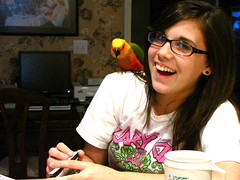You’ve got some basic ideas of what your character is like: gender, age, vocation, manner.
As described in Finding and Creating Characters, you’ve given your character a problem, a need.
Now you’re ready to flesh the character out. Even though you won’t reveal all this information about your character at first, you need to know enough about the character so his or her actions make sense. Tags, traits, and relationships help you turn a one-dimensional stereotype into a three-dimensional unique character.
Tags help readers identify, differentiate, and distinguish between characters.
- Name
- The name must be consistent with character traits and age. Different names are popular in different generations. Tiffany is more appropriate for a young woman than a senior citizen, and Bruce doesn’t sound like an action/adventure hero.
- The character’s name should be easy to spell and pronounce. If you need an ethnic name that is hard to spell and pronounce, you can give the character an easy nickname.
- Keep the name consistent throughout the story. If your heroine is called Jacquie, don’t identify her as Jacqueline Marie and Ms. Morgan except in dialogue.
- Your characters’ name should have different beginning letters, sounds, and lengths. Readers can be confused if your main characters are named Joe, Josie, and Joni.
- You can find character names in baby name books and Web sites or The Writer’s Digest Character Naming Sourcebook
.
- Appearance
- Identify them by gender and age. You don’t have to specify an exact age, but twenty-something is different from middle-age or senior.
- Describe their appearance. You don’t need a detailed description of every aspect of their appearance; you need two or three major elements of their appearance that will create an image for the reader.
- Other Tags
- Vocation—The CEO of a construction company will be different in a variety of ways from a laborer on the construction crew.
- Avocation/hobby—What a person chooses to do for fun tells a lot about them.
- Speech—Word choice, accent, and jargon can indicate level of education, ethnic or regional background, vocation, and more.
- Mannerisms—Habits and typical behaviors make characters distinctive.
- Attitude—Behavior patterns and the character’s typical way of reacting lead to characters’ actions and reactions.
- Abilities—Specific combinations of skills and talents make characters unique.
Goals and motivation
- Know what they aim to accomplish. They could be after love, revenge, financial security, adventure, or a myriad of other goals.
- Understand their motivation. Why are they looking for love? What happened to them to motivate them to seek revenge? Why is financial security so important to them?
Traits are characters’ habitual modes of response and habitual behaviors.
- Characters, like people, have distinctive ways of reacting to life’s demands that become habitual.
- Their influences, memories, history, and emotions have helped to form the way they typically act and respond to crises.
- Give your characters specific traits so you can introduce them by the characters’ actions before a crisis. Your story people should act “in character” in a crisis so your readers find their actions believable. I’ve been known to say, “She would never do that!”
Relationships are the way characters interface with others, the associations and reactions to people they come in contact with.
- Attraction is a paradox:
- Like attracts like.
- Opposites attract.
- People-watch to see how different people relate to others around them.
Cast your character to type or against type.
- To type—The character fits the stereotype of the dominant impression: the nerdy bookkeeper who wears glasses and reads boring academic books.
- Against type—The character doesn’t fit the stereotype of the dominant impression: the bookkeeper who works out regularly and races cars for a hobby.
Make your characters non-perfect—give them weaknesses.
- Readers can’t identify with perfect characters. None of us is perfect, and we want characters to be believable.
- Use the characters’ flaws and weaknesses to control the readers’ reaction to the character.
- Make them like or dislike the character, accept or reject him or her by the flaws you give your story people.
- Readers will hate the villain who tortures small animals but will love the hero who procrastinates.
Show, don’t tell.
- Traits are abstract and general; actions are concrete and specific. Telling the reader that your character procrastinates isn’t nearly as effective as showing him missing a deadline or failing to finish a project. One late project won’t identify an procrastinator, but several such incidents will.
- With the testimonial technique, you can have other characters describe the character by relating incidents: Joe’s coworker can say “Joe was late on his project again. He …”
Where do get material?
- Observing other people—there’s nothing like people-watching to get ideas for your characters.
- Introspection of your own self—you know yourself better than anyone, and your traits can give you ideas for your characters.
- Reading other fiction writers—see what works well and how you can adapt techniques to your own characters.
The next installment will cover developing background and traits using a character chart, bio, diary, or interview.
Share your own character-building tips in comments.

